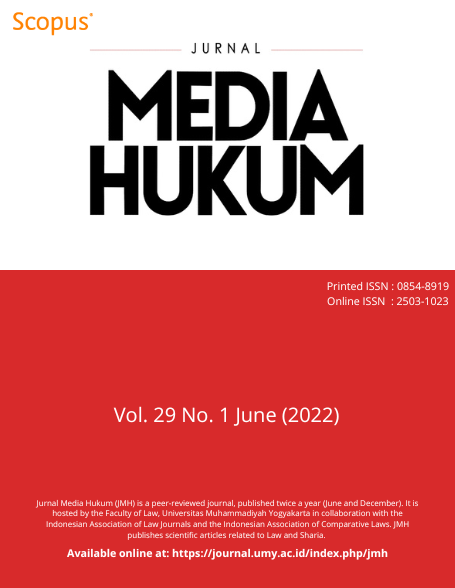Disaster Mitigation in Coastal Areas: Perspective of the Indonesian Spatial Planning Law
DOI:
https://doi.org/10.18196/jmh.v29i1.14685Keywords:
coastal areas, disaster mitigation, spatial planningAbstract
This article is a critical analysis on spatial planning with regard to disaster mitigation in coastal areas. The author explores the concepts and regulations of disaster mitigation and spatial planning in Indonesian coastal areas to identify how spatial planning works in terms of disaster mitigation in coastal areas and the roles of stakeholders in disaster mitigation in coastal areas in the context of the spatial planning law. This normative legal research was conducted by examining secondary data from relevant books, journals, and published documents. This study finds out that, first, according to the Spatial Planning Law, Management of Coastal Zone and Small Islands Law, Disaster Management Law, Job Creation Law, and their derivative regulations, there have been regulations mandating spatial planning as a non-structural mitigative measure with regard to disaster management in coastal areas. Second, in terms of spatial planning and disaster mitigation, the government is the dominant stakeholder, while the role of non-government stakeholders is not expressly provided for which may eventually result in "tokenism" participation in disaster mitigation in coastal areas.
References
Altay, N., & Green, W. G. (2006). OR/MS Research in Disaster Operations Management. European Journal of Operational Research, 175(1), 475-493
Arnstein, S. R. (1969). A Ladder of Citizen Participation. JAIP, 35(4), 216-224
Arumbinang, M. H. (2021). Problems and Dilemmas: ASEAN Commitments in Disaster Management. Indonesian Comparative Law Review, 4(1), 17-25. https://doi.org/10.18196/iclr.v4i1.13219
Begum, R. A., Sarkar, Md., Kabir, S., Jaafar, A. H., & Pereira, J. J. (2014). Toward Conceptual Frameworks for Linking Disaster Risk Reduction and Climate Change Adaptation. International Journal of Disaster Risk Reduction, 10, 362–373. http://dx.doi.org/10.1016/j.ijdrr.2014.10.011
Bosher, L. (2008). Hazards and the Built Environment: Attaining Built-In Resilience. Routledge
Callaghan C. W. (2016). Disaster Management, Crowdsourced R&D and Probabilistic Innovation Theory: Toward Real Time Disaster Response Capability. International Journal of Disaster Risk Reduction, 17, 238-250.
Christoplos, I., Mitchell, J., & Liljelund, A. (2001). Re-Framing Risk: The Changing Context of Disaster Mitigation and Preparedness. Disasters, 25(3), 185–198. https://doi.org/10.1111/1467-7717.00171
Coburn, A. W., Spence, R. J. S., & Pomonis. A. (1994). Disaster Mitigation. UNDP
CRED and UNDRR. (2020). The Human Cost of Disasters - An overview of the last 20 years 2000-2019. https://www.undrr.org/publication/human-cost-disasters-overview-last-20-years-2000-2019#:~:text=In%20the%20period%202000%20to,over%20the%20previous%20twenty%20years.
Cuaresma, C. J., Hlouskova, J., & Obersteiner, M. (2008). Natural Disasters as Creative Destruction? Evidence from Developing Countries. Economic Inquiry, 46(2), 214-226.
Diposaptono, S. (2003). Mitigasi Bencana Alam di Wilayah Pesisir dalam Kerangka Pengelolaan Wilayah Pesisir Terpadu di Indonesia. Alami, 8(2), 1-8
Doody, J. Pat. (2001). Coastal Conservation and Management An Ecological Prespective. Kluwer Academics Publisher
Endyka, Y., Muhdar, M., & Sabaruddin, A. (2020). Environmental Justice in Intra Generations: An Overview of Aristotle's Distributive Justice to Coal Mining. Indonesian Comparative Law Review, 3(1), 25-34. https://doi.org/10.18196/iclr.v3i1.11234
Freeman, R. E., Harrison, J. S., Wicks, A. C., Parmar, B. L., & De Colle, S. (2010). Stakeholder Theory: The State of The Art. Cambridge University Press.
Government Regulation Number 21 of 2008 concerning Disaster Management
Government Regulation Number 64 of 2010 concerning Disaster Mitigation in Coastal Areas and Small Islands
Gunawan, Y., & Arumbinang, M. H. (2021). Indonesian Forced-Labour Crew in Chinese Vessel: A Human Rights Perspective. Sociology and Technoscience, 11(2), 115-133.
Horney, J., Nguyen, M., Salvesen, D., Tomasco, O., & Berke, P. (2016). Engaging The Public in Planning for Disaster Recovery. International Journal of Disaster Risk Reduction, 17, 33–37
Hui, H., Lei, T., Lei, J., Zhang, S., & Kavan, P. (2018). Disaster-Mitigating and General Innovative Responses to Climate Disasters: Evidence from Modern and Historical China. International Journal of Disaster Risk Reduction, 28, 664-673
Ibrahim, J. (2007). Teori dan Metodologi Penelitian Hukum Normatif: Cetakan Ketiga. Bayumedia Publishing
International Strategy for Disaster Reduction (ISDR). (2009). Terminology on Disaster Risk Reduction. https://www.undrr.org/publication/2009-unisdr-terminology-disaster-risk-reduction
International Strategy for Disaster Reduction (ISDR). (2010). Local Governments and Disaster Risk Reduction: Good Practices and Lessons Learned. https://reliefweb.int/report/world/local-governments-and-disaster-risk-reduction-good-practices-and-lessons-learned
IPCC. (2012). Managing the Risks of Extreme Events and Disasters to Advance Climate Change Adaptation. A Special Report of Working Groups I and II of the Intergovernmental Panel on Climate Change. Field, C.B., V. Barros, T.F. Stocker, D. Qin, D.J. Dokken, K.L. Ebi, M.D. Mastrandrea, K.J. Mach, G.K. Plattner, S.K. Allen, M. Tignor and P.M. Midgley. Cambridge University Press
Kahneman, D., & Tversky, A. (1979). Prospect Theory – Analysis of Decision Under Risk. Econometrica, 47(2), 263-291. https://doi.org/10.2307/1914185
Kousky, C. (2014). Informing Climate Adaptation: A Review of The Economic Costs of Natural Disasters. Energy Economics, 46, 576-592
Kron, W. (2008). Coast- The Riskiest Places on Earth. https://www.asianscientist.com/wp-content/uploads/2012/07-new/9789814277426_0001.pdf
Law Number 1 Year 2014 concerning Amending Law Number 27 Year 2007 on the Management of Coastal Zone and Small Islands
Law Number 11 Year 2020 concerning Job Creation
Law Number 24 Year 2007 concerning Disaster Management
Law Number 26 Year 2007 concerning Spatial Planning
Law Number 27 Year 2007 concerning the Management of Coastal Zone and Small Islands
Levy, J. M. (2016). Contemporary Urban Planning: Eleventh Edition. Routledge
Lyster, R., & Verchick, R. R. M. (2018). Research Handbook on Climate Disaster Law (Barriers and Opportunities). Edward Elgar Publishing
Marzuki, P. M. (2010). Penelitian Hukum: Cetakan Keenam. Kencana Prenada Media Group
Moe, T. L., & Pathranarakul, P. (2006). An Integrated Approach to Natural Disaster Management Success Factors. Disaster Prevention and Management, 15(3), 396-413.
Mojtahedi, S. M. H., & Lan Oo, B. (2014). Stakeholders’ approaches to disaster risk reduction in built environment. Disaster Prevention and Management 23(4), 356-369. https://doi.org/10.1108/DPM-11-2013-0209
Morgan, M. G. (2013). Readings in risk, in Glickman, T., & Gough, M. (eds) Readings in Risk. Resources for the Future
Mubarak, A. F., Amiruddin, R., & Gaus, S. (2019). The Effectiveness of Disaster Prevention and Mitigation Training for The Students in Disaster Prone Areas. OP Conf. Ser.: Earth Environ. Sci. 235 012055. https://doi.org/10.1088/1755-1315/235/1/012055
National Disaster Management Agency. (2020). Annual Report 2019. https://bnpb.go.id/documents/laporan-kinerja-2019-51-1587446756.pdf
Nichersu, I., & Iacoboae, C. (2011). Systematic Spatial Planning. Theoretical and Empirical Researches in Urban Management, 6 (2), 67-77
Nugroho, S. S., Haq, H. S., & Erwin, Y. (2020). Hukum Mitigasi Bencana di Indonesia. Lakeisha
Office of Inspector General (US Department of Homeland Security). (2009). FEMA's Progress in All-Hazards Mitigation. https://www.oig.dhs.gov/assets/Mgmt/OIG_10-03_Oct09.pdf
Pancasilawan, R., Utami, S. B., Sumaryana, A., Ismanto, S. U., & Rosmalasari, D. (2020). Mitigation of Disaster Risk Reduction in Pangandaran Regency. Sosiohumaniora 22(2), 214 - 222. https://doi.org/ 10.24198/sosiohumaniora.v22i2.25792
Pinkowski, J. (2008). Disaster Management Handbook. Taylor & Francis Group
Puturuhua, F., & Christianty, R. (2020). Disaster Risk on Review Scale and Spatial Planning Archipelago Region: The Risk Based Island Cluster In Moluccas Province. Jambura Geoscience Review, 2(2), 94-105. http://ejurnal.ung.ac.id/index.php/jgeosrev
Regulation of the Head of the National Disaster Management Agency Number 1 of 2012 concerning Guidelines for Disaster-Resilient Villages
Skidmore, M., & Toya, H. (2002). Do Natural Disasters Promote Long-Run Growth? Economic Inquiry, 40(4), 664-687.
Sorensen J. C., & Mc Creary. (1990). Coast: Institutional Arrangement for Managing Coastal Resources. University of California
Sutanta, H., Rajabifard, A., & Bishop, I. D. (2010). Integrating Spatial Planning and Disaster Risk Reduction at the Local Level in the Context of Spatially Enabled Government. https://www.semanticscholar.org/paper/Integrating-Spatial-Planning-and-Disaster-Risk-at-Sutanta-Bishop/8dcd5a80f45e3be877b2b5ccaa1ac525248e61eb
United Nation. (2020). Staggering Rise in Climate Emergencies in Last 20 Years, New Disaster Research Shows. https://news.un.org/en/story/2020/10/1075142
Walker, G., Deeming, H., Margottini, C., & Menoni, S. (2011). Introduction to Sustainable Risk Mitigation for a More Resilient Europe. In: Menoni, S., & Margottini, C. (eds) Inside Risk: A Strategy for Sustainable Risk Mitigation. Springer, Milano. https://doi.org/10.1007/978-88-470-1842-6_1
Webster, M. (1828). Black Law Dictionary. West Publishing










